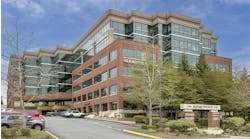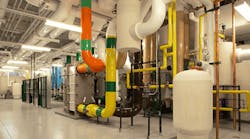MILWAUKEE — Johnson Controls’ Glendale, Wis., corporate campus, consisting of four buildings, is a model of energy efficiency and sustainability, which recently received U.S. Green Building Council LEED Platinum certification, representing the largest concentration of LEED Platinum buildings on one site ever awarded.
The campus headquarters incorporates a variety of sustainable technologies and systems, including a geothermal system, ground-mounted solar photovoltaic array and solar film, and a solar thermal water heating system. Plus, there is also a rooftop rainwater collection system, filtering and storing water for water closets and urinals.
The company's energy usage has been reduced by 21%, despite the recent doubling of space by adding 160,000-sq.ft. Greenhouse gas emissions have also been reduced, annually, by more than 827,000 pounds of carbon dioxide equivalent due to the on-site solar electricity generation. Plus, water usage has been reduced by 595,000-gal. annually by collecting and recycling rainwater and the addition of low-flow plumbing fixtures.
When asked what it means for Johnson Controls to have the largest concentration of LEED Platinum buildings on one site ever awarded, Iain Campbell, VP & GM, Global Energy and WorkPlace Solutions at Johnson Controls told CONTRACTOR that it’s most important for the company to showcase sustainable technologies that do have a payback.
“We can’t tell the market to do this unless we do it ourselves, demonstrating our commitment to our values around social responsibility and sustainability,” said Campbell. “We also wanted to show that this is practical, affordable and has a very positive financial payback.”
Geothermal system
A closed-loop geothermal system, consisting of 272 wells drilled 300-ft. deep each, heats and cools the campus buildings. The system is made up of a plate-to-plate heat exchanger, pumps, chillers, heat pump, piping, manifolds and valves. Some of the piping was pre-manufactured off site.
“We have access to temps 55°F-60°F degrees,” explained Campbell. “When we are in cooling mode, instead of sending condensate water into the cooling tower, we are running it underground and cooling condensate water that way. Chillers and heat pumps are running much more efficiently.”
According to Ward Komorowski, director of Facilities and Building Services at Johnson Controls, the system is running about 30% more efficient. In the early part of the summer the chillers are 0.27 kW per ton since condensing water is being used.
“As we go through summer and we use geothermal as the condenser, the temperatures and the ground mass heats up, so we have 70°F degree water coming back at the end of summer, so the chiller operates at 0.5 kW per ton,” said Komorowski. “All in all an average for the whole cooling season is about a 0.4 kW per ton which is around 30%-33% more efficient.”
During the winter months, condensing water is utilized at 140°F degrees to heat the building along with some of the chilled water being produced off the heat pumps to cool the building.
“We have cooling loads in the electrical rooms, wiring closets and cafeteria equipment where there are cooling loads all year long,” explained Komorowski. “We take excess water and put it back in the earth and start to cool the earth back down for the next year to come through. We are using it as a big heat sink.”
Campbell told CONTRACTOR that the bottom line concerning the geothermal system is that it delivers a 30% reduction in energy consumption compared to traditional systems.
It took approximately six months from start to finish, including drilling the wells and building the mechanical system. The site of the project did present challenges since it was large in size and consists of a wet land and stream.
“We call it a “sustainable sandwich,” photovoltaics (PV) on top and geothermal wells beneath,” said Komorowski. “We had site coordination issues with trying to map out where the wells are. We actually had to borough under a stream that cuts through the property. Then there was the silt buildup that comes with drilling 272 wells 300-ft. deep each. We also needed a DNR permit since we had to go under the stream. When we started to drill, soil conditions changed drastically throughout the site, so we needed to retool the drill tips. We were dealing with sand clay and stone on the site, and it was a tight site.”
Solar systems
On the campus grounds, 1,452 solar photovoltaic panels make up one of the largest arrays in Wisconsin, delivering up to 250kW of electricity. Plus, approximately 14,000-sq.ft. of thin-film PV cells are laminated on the roofing membrane of an existing building built in 1967 to generate electricity.
“The solar film doesn’t have the same load as crystalline PV,” explained Komorowski. “It’s low cost to put up and ideally suited for roofs with out a lot of weight or structural capacity.
“Structurally it creates a no load on the roof,” said Komorowski. “Crystalline PV creates snow load drifting issues on the roof because of the angle, so then you have to raise them up high and then you have to be concerned about uplift structurally from the wind. So the advantage is we could apply it to the existing structure without modifying any of the structure, which eliminated a huge issue.
The project also consists of a solar thermal system, which is glycol based and made up of 34 solar panels. The glycol goes through tubes, which gets heated up and goes down to a heat exchanger, which transfers heat into the domestic hot water system.
According to Komorowski, the solar thermal system probably has the fastest payback.
Plumbing, monitoring systems
The campus buildings are utilizing water conserving plumbing fixtures by Kohler and a rainwater collection system. A three acre parking lot was also resurfaced with permeable paving blocks allowing rainwater and snowmelt to be collected and retained on-site.
“We have a rainwater collection system that collects rainwater from the roof to flush water closets and urinals,” said Komorowski. “We also have a cistern that collects rain water from the site’s hardscapes and uses it for the small amount of drip irrigation and lawn sprinklers. The majority of the site has adaptive and native plants which do not require an irrigation system.”
Komorowski told CONTRATOR that the one challenge when designing and installing the rainwater collection system and the processes the rainwater needs to go through to use it in the toilets and urinals was to conform with the state’s requirement and gain its approval.
“The water goes through several filters, a charcoal filter, and then a UV filter, and then it goes into a storage tank and then it is used,” said Komorowski. “The rainwater capture and recycling reduces water by 77% from using recycled rainwater.”
The campus buildings are also connected to Johnson Controls Metasys building management system to coordinate all activities across the facilities and provide a single point of access to performance indicators — the information required for optimizing building efficiency, comfort and safety. A desk top control system is also connected into Metasys. Employees can adjust their volume of air and the temperature as well as white noise cancellation. Plus, an occupancy sensor controls their micro environment so when they leave the workstation their personal environment and task lighting turns off, reducing air conditioning and electrical loads.




